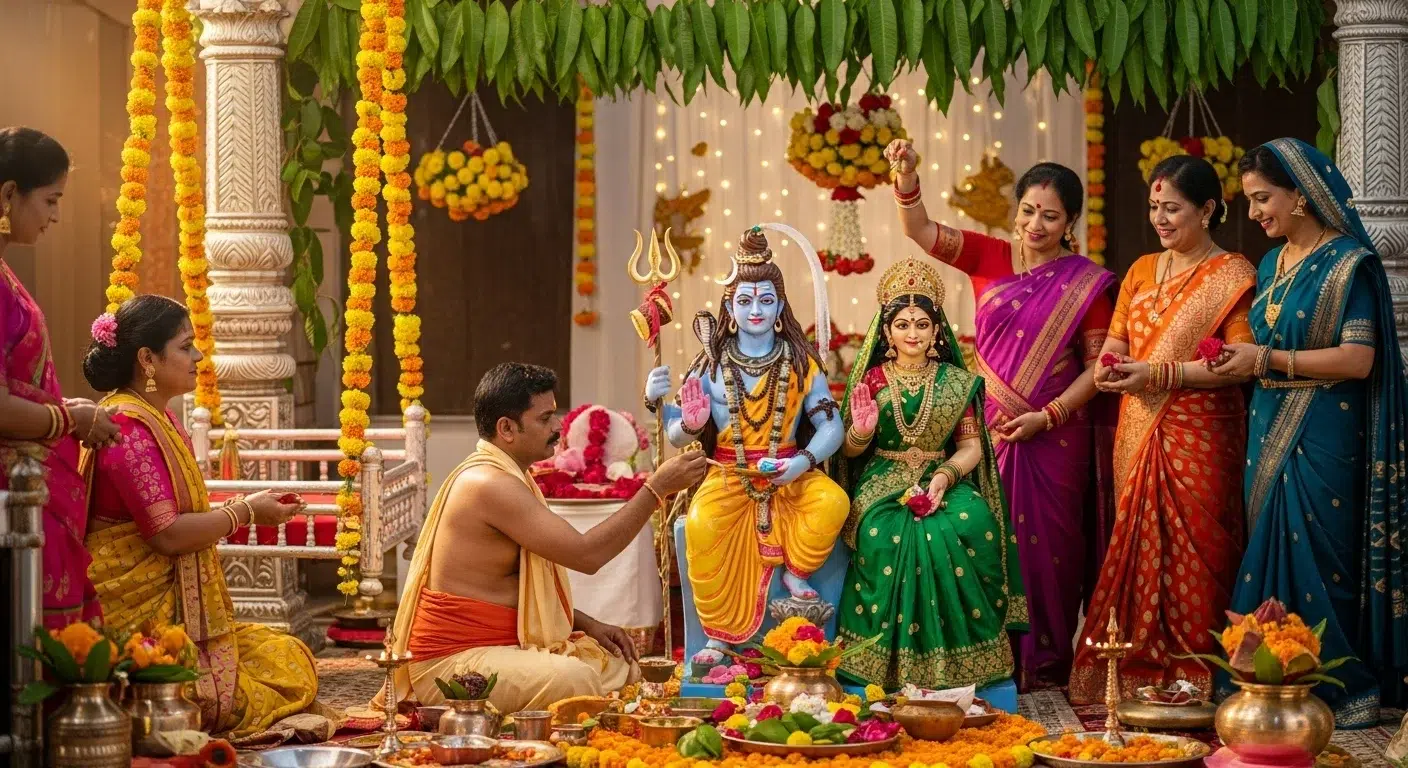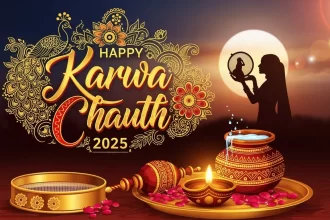Hariyali Teej is a vibrant and deeply significant festival celebrated primarily by women in North India. It celebrates the onset of monsoon while skillfully weaving the Shaivite and Shakti divine love story of Lord Shiva and Goddess Parvati. This is a day of festivities marked by devotion to Shiva and Parvati.
The celebration of Teej is essential to Goddess Parvati and to the people who regard her as the powerful woman of love and devotion to their husbands. Teej pays homage to the valiant depiction of love in the ancient tradition of brave love stories.
Hariyali Teej 2025: Date and Shubh Ghadi
The festival will be celebrated on Sunday July 27, 2025.
- Tritiya Tithi Begins: 10:41 PM on July 26, 2025
- Tritiya Tithi Ends: 10:41 PM on July 27, 2025.
The festival is celebrated on the Tritiya (third day) of the Shukla Paksha (bright 15 days) in the Hindu month of Shravan (Sawan). This month is renowned for the green land in monsoon showers.
Why is Hariyali Teej Celebrated? It’s a Divine Love Story
The epic tale of Shiva and Parvati is the essence of Hariyali Teej. In Hindu mythology, the story goes that Goddess Parvati did a hard penance which included 108 births for the chance to have Lord Shiva as her husband. Her great determination and devoted spirit finally resulted in Lord Shiva accepting her as his wife on this very day.
- Symbol of Undying Love: Hariyali Teej marks this reunion, representing joyful marriage, a perfect couple, and the exceptional strength of a woman’s devotion.
- Prayers for Marital Bliss: Women observe this day to pray for the long and healthy life of the husband along with a happily married life. Even single women participate to make a wish for a life partner who is as loving and devoted as Lord Shiva.
- Nature’s Bounty: Hariyali means “greenery”, which serves as a representation of the monsoon season. It also symbolizes the renewal of nature and fertility along with growth.
Celebrating Hariyali Teej: Pujas and Celebratory Rituals

The celebration of Hariyali Teej is conducted with great devotion and elaborate puja rituals and dharams, all of which have to do with the celebration of women. Here are the rituals that women usually perform:
1. The Nirjala Vrat (Strict Fast)
- Nirjala Vrat is practiced by most married ladies who undertake fasting rigorously by neither eating nor drinking water of any amount. The fasting period starts at sunrise and is concluded after worship and moon sighting in the evening or the following morning. This fasting ritual is of utmost importance, demonstrating their devotion and commitment to their husbands.
2. Solah Shringar (Adorning Oneself)
- Their attire includes bright red or green sarees which are traditional and signify marital bliss, growth and prosperity. Celebration of marriage is highlighted through the use of color which represents the optimism associated.
- The ritual of applying mehndi (Henna) onto the hands and feet is vital and extremely important during weddings. The mehndi is believed to symbolize good luck and love, so its deep and dark coloration confirms the love between the couple.
- Completing the attire is Solah Shringar which refers to the sixteen traditional bangles, and especially green ones, bindi, and adorned with sindoor, and traditional jewelry including nose rings and earrings.
3. Shiv-Parvati Puja
- Worship of Hariyali Teej includes a special puja with images or idols of Lord Shiva, Lady Parvati, and Lord Ganesha, which is done with great devotion.
- As a sign of love and faith, the deities are ritually bathed, receive new garments, and are presented with different offerings. The offerings are:
-
- Offering Solah Shringar items to Goddess Parvati (saree, bangles, sindoor, bindi, alta, comb, mirror, etc.)
- Bael Patra, Datura, and Cannabis are some of the auspicious items offered to Lord Shiva.
- Devotees of Lord Shiva also prepare sweet dishes, specially ‘Ghevar’, fruits, and flowers along with coconut and betel nut.
- Devotees also light diyas and incense sticks, reciting mantras dedicated to Shiv and Parvati alongside the fasting story, Hariyali Teej Vrat Katha, which recounts the tale of Parvati’s penance.
- Puja samagri (worship items) are offered to Shiva and Parvati, and the puja is concluded with Aarti (waving of diya/lamps) and Prasad (blessed food) is distributed.
4. Sindhara Tradition
- On the day of Hariyali Teej, or the day before, married women are gifted Sindhara, which is a traditional ‘gift basket’ from their parents. This gift includes green sarees, new blouses, traditional jewelry, cosmetics, bangles, and sweets including Ghevar. This gift is a sign of the parent’s love and blessing’s of a happy married life.
5. Jhoola (Swing) Fun and Folk Songs
- Women’s enjoyment of swinging or ‘jhoola’ from tree swings is a delightful tradition of Hariyali Teej. This takes place in the courtyards or gardens, and with the women, singing traditional Teej songs and celebrating through dancing and laughing and stories are shared in stamina to monsoons, showing the sheer joy and freedom as a married woman.
Must Read: 5 Must-Visit Iconic Shiva Temples Outside India for a Divine Experience (2025)
Regional Celebrations of Hariyali Teej
While the core rituals remain similar, the celebrations of Hariyali Teej vary slightly across different regions of North India:
- Rajasthan: Grand processions of Goddess Teej Mata (Goddess Parvati) are carried out with much pomp and show in Jaipur. The women dress in traditional Lehariya saree.
- Uttar Pradesh & Bihar: The women sing special Teej songs, swinging back and forth on jhoolas, while enjoying great enthusiasm and traditional feasts.
- Madhya Pradesh & Haryana: Similar customs take place in both states, where women fast, get mehndi applied, and give and receive gifts, particularly newly married women.
Ways to celebrate Hariyali Teej 2025
- Embrace Green: Wear the colour green to convey freshness, prosperity and the rainy season.
- Connect with Family: Hariyali Teej is a wonderful chance to reconnect with family and friends. It is a unique opportunity for a family gathering, like during the Teej gathering with your maternal family will allow family connection.
- Get Involved: Once again whatever you can do whether fasting, puja, or just singing and swinging, get involved.
- Learn the Katha: It is believed that when a person listens to the Hariyali Teej Vrat Katha, it is considered important in completing the fast and understanding its importance as one of the Hareliya Teej spiritual meanings.
Must Read: Explore 10 Most Popular Shiva Temples in North India
Do’s and Don’ts During Hariyali Teej
To maintain the sanctity of the Vrat and the festival, certain guidelines are traditionally followed:
Do’s:
- Wear green clothes and ornaments.
- Listen or read the entire Hariyali Teej Vrat Katha.
- During the puja, keep purity of thought and environment.
- Use sustainable decorations for the swings and temples.
Don’ts:
- Do not eat or drink anything if you are observing nirjala Vrat.
- Do not argue or voice negativity.
- Do not omit the puja ritual if you are observing the fast.
- Do not use any synthetic or plastic decorations.
Modern Perspective: Teej in 2025
While we live in a complicated and fast-moving urban world, Hariyali Teej retains its homage to tradition while embracing modern-day values. From different life stages, women commit to sisterhood, devotion to Lord Shiva, and cultural pride, regardless of who or where they are – even in big cities where societies and apartments continue to organize Teej melas, mehendi competitions, and cultural shows that carry the tradition forward.
An awakening eco-modernism has led to sustainable practices such as using natural colors, less plastic, and homemade sweets for the Teej celebration.
Conclusion
Hariyali Teej is a festive event and festival as well as a warm tribute to enduring power of love, faith and tradition and it is not only a religious celebration. It is a celebration of women’s energy, nature, tradition and eternal love. It also reminds us of the relationship of Lord Shiva to Goddess Parvati which provides inspiration for all couples. As we come to Hariyali Teej 2025 we may wear colourful clothing, move forward with rituals, and have a joyous experience for all. A reminder that love, faith, and tradition continues from generation to generation in our lives.







